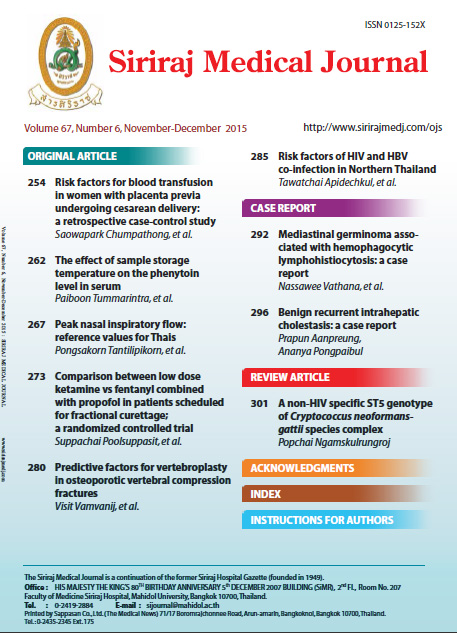Predictive Factors for Vertebroplasty in Osteoporotic Vertebral Compression Fractures
Abstract
Objective: To identify predictive factors for performing percutaneous vertebroplasty (PVP) after osteoporotic vertebral compression fractures (OVCFs).
Methods: A retrospective review of medical record of patients who presented with OVCF between April 2007 and March 2010 was conducted. Specific data collected in each group such as gender, age, and radiographic parameters were analyzed by statistical methods.
Results: Fifty six patients (28 vertebroplasty, 28 conservative treatment) were enrolled. Severity of collapsed osteoporotic fracture more than 40% showed significant association with vertebroplasty (p=0.002). Other factors such as gender, age, fracture age, mechanism of trauma, and kyphotic angle had no statically significant association with vertebroplasty.
Conclusion: Our findings suggested that osteoporotic patients who had severe vertebral fracture collapse more than 40 % significantly underwent percutaneous vertebroplasty. Because of small sample size, further prospective systematic multicenter trials intended to investigate other risk factors are needed.
Keywords: Vertebral compression fracture, vertebroplasty, predictive factor, osteoporosis
Downloads
Published
How to Cite
Issue
Section
License
Authors who publish with this journal agree to the following conditions:
Copyright Transfer
In submitting a manuscript, the authors acknowledge that the work will become the copyrighted property of Siriraj Medical Journal upon publication.
License
Articles are licensed under a Creative Commons Attribution-NonCommercial-NoDerivatives 4.0 International License (CC BY-NC-ND 4.0). This license allows for the sharing of the work for non-commercial purposes with proper attribution to the authors and the journal. However, it does not permit modifications or the creation of derivative works.
Sharing and Access
Authors are encouraged to share their article on their personal or institutional websites and through other non-commercial platforms. Doing so can increase readership and citations.










